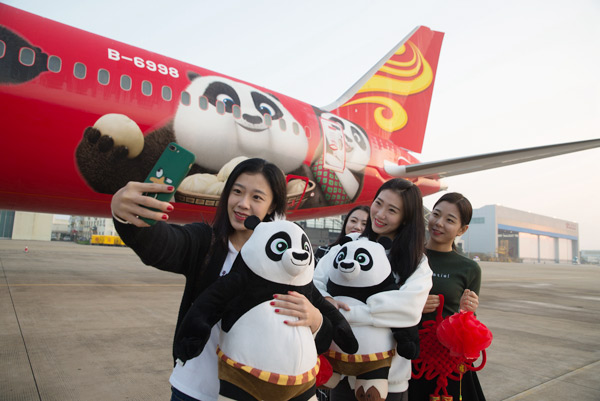World's on Hainan Air's radar
 |
|
Passengers take selfies in front of a Hainan Airlines' plane after a panda-themed flight from Haikou to Beijing in late January. [Photo provided to China Daily] |
Carrier rides boom in tourism, easier visas and economic drives
Hainan Airlines Co Ltd, China's biggest private airline by both market share and fleet size, will launch over 10 international flights this year.
Among them will be the Chengdu-Los Angeles and Chongqing-Los Angeles air routes.
This global push will help Hainan Airlines, a subsidiary of Chinese conglomerate HNA Group, to compete with established rivals in both domestic and global markets.
The new flights are expected to make the most of the opportunities presented by the boom in Chinese outbound tourists. Also, economic growth campaigns like the Belt and Road Initiative and various bilateral free trade agreements have led to a rise in people-to-people exchanges, which is spurring demand for flights to certain destinations.
There are other reasons as well for Hainan Airlines' expansion of its services.
"In comparison with 2016, a growing number of countries are working on simplifying visa procedures for Chinese travelers, including introduction of digital visas, lowering of visa fees and shortening waiting periods," said Sun Jianfeng, president of Hainan Airlines.
Chinese tourists made 109 million outbound trips in 2016, up 11 percent year-on-year, accounting for 9.6 percent of global tourists, data from the Beijing-based World Tourism Cities Federation show.
They spent $165 billion across the world in 2016, up 28 percent year-on-year, contributing 11 percent of international tourism revenue.
The Haikou-based company launched 10 long-haul routes, including Beijing-Las Vegas, Xi'an-Sydney and Beijing-Calgary, in 2016. Its flights reach more than 200 domestic and global cities, including to 10 eight cities in North America, which are served by direct flights.
The airline operates more than 180 aircraft, one of the world's largest commercial carrier fleets. Its sales revenue was 17.68 billion yuan ($2.57 billion) in the first half of 2016, up 13 percent year-on-year.
Hou Wei, senior vice-president of Hainan Airlines, said traffic rights for routes connecting major cities are tight, so direct flights to second-tier cities are practical.
"Direct flights between first-tier Chinese cities and second-tier foreign cities, as well as second-tier Chinese cities and top-tier foreign cities, are expected to grow rapidly in the future, given the significant demand for international travel in China," said Hou.
"Passengers certainly prefer non-stop services. We analyze the markets city by city, to study their economic development models, annual fiscal performance, average income and their demographics, like if the majority of their populations are turning into middle class consumers given to wanderlust."
In addition to launching new routes and regularly increasing its fleet to boost revenue, Hainan Airlines started hiring crew members like flight attendants in countries such as Japan, the United Kingdom, France and Russia last year.
It currently has more than 4,500 flight attendants. Over 200 of them are from Hong Kong, Macao as well as foreign countries.
"Even though Hainan Airlines is a latecomer to the global market, pursuing a "differential competitive strategy" is necessary for the company, as other carriers have already scooped up many market resources," said Li Xiaojin, a professor at the Civil Aviation University of China in Tianjin.
In taking on competitors, Hainan Airlines has to deal with the reality that China's civil aviation market is dominated by "the Big Three": State-owned carriers Air China, China Eastern Airlines and China Southern Airlines.
Li said air traffic across the Pacific Ocean-growth here is rare-has been growing of late off the back of a new visa policy of the United States. At the end of last year, the US started issuing 10-year multiple-entry visas to Chinese nationals in place of one-year tourist visas.
The visa application process has also been simplified, and this has stimulated airline sales growth. Expanding China-US trade has also helped boost the industry.
The company also plans to play a bigger role in advancing transportation services this year for multilateral cooperation in countries along the Belt and Road Initiative.
The infrastructure, trade and services network proposed by the Chinese government in 2013 envisions a Silk Road Economic Belt and a 21st Century Maritime Silk Road, covering about 4.4 billion people in more than 60 countries and regions in Europe, Asia and Africa.
"We will launch more routes connecting China with countries and regions along these two trading routes to assist our counterparts build and operate airports to improve local transportation services and introduce high-end tourism routes with distinct Silk Road factors," said Sun.
Hainan Airlines launched its first flight in 1993, and has since become a global aviation giant boasting $86.34 billion in assets and about 200,000 employees in China and abroad, according to company data.
It has built a presence in aviation, logistics, hospitality, tourism and ecological technology.
Zhu Wenqian contributed to this story.

















